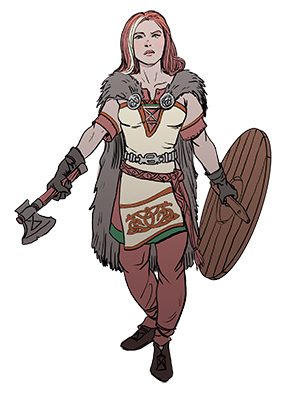Raiment
By D. Koch
One’s appearance and how one carries oneself indicates social status. Raiment is a distinctive aspect of one’s appearance that also serves practical purposes during inclement weather. The Bjornings prize one’s clothing and overall appearance as a mark of beauty over any particular facial feature.
Raiment
Raiment is something adventurers wear that is distinctive and adds to their reputation. Raiment does not use inventory slots and it is maintained in town for free. Raiment cannot be resold.

Enchanted Clothing (SG, p. 157)
In addition to its standard benefit as gear, enchanted clothing counts as raiment and can’t be sullied by bad conditions.
Paying the Toll with Raiment (LMM, p. 142)
The toll accrued on a journey must be paid down with food and drink, coins, gear, raiment or conditions. No rolls are necessary in this process.
Raiment’s Aegis (LMM, p. 143)
If an adventurer’s raiment is appropriate to the journey or weather, it reduces their toll by one for free. It is not expended in the bargain.
Attire
The traditional garb of the Bjorning dominates the fashion of Rimholm. The Bjornings have recently adopted a particular style of finery, the bunad, worn during important gatherings, festival days, a Thing, or meetings. Silk garments are reserved for the wealthiest of high-ranking clan leaders, hersar, or jarls.
All of the tribes take pride in the embroidery and stitching of every garment of clothing. Even the least expensive dress in the market is anointed with intricate patterns and exquisite filigree ornamentation.
Families have distinctive colors, patterns, or cuts to their bunad. If you're Rimholm-wise, you should be able to tell which clan or even bloodline someone belongs to by their bunad.
Clothing patterns and designs are particular to each clan and each region, and people can often ascertain your homeland without asking. Karls have an extra, nicer outfit of finery for clan ceremonies. Day dresses are not as formal or decorative as a bunad and are easier to make, and these garments are adorned with scarves, shawls, or wraps.
Like the colorful buildings along the harbor, the attire of the people flaunts vibrant hues. Bunads are usually dyed brilliant colors—especially yellow, green, and orange. Some shades of red or blue can inexpensively be made from imported dyes from Osterland, however, true blue, vibrant red, and purple colors are expensive and reserved for nobility. Each family sews a bunad as an auspice of nurturing, and purchasing such a garment in the market is unthinkable. Visitors staying in the city for extended periods will often receive a bunad as a gift from a host family as a token of appreciation. Men will often top off their bunad with a black, wide-brimmed hat.
The pants in Rimholm range from baggy to tight. It's customary for the pants to be held up by a belt and straps under the heel. Women usually wear wool frocks and suspenders fashioned with a metal brooch, or solje. The solje represents the sun and appears on collars or cuffs as a finishing touch.
Artwork by Thomas Denmark. © Chalk Horse